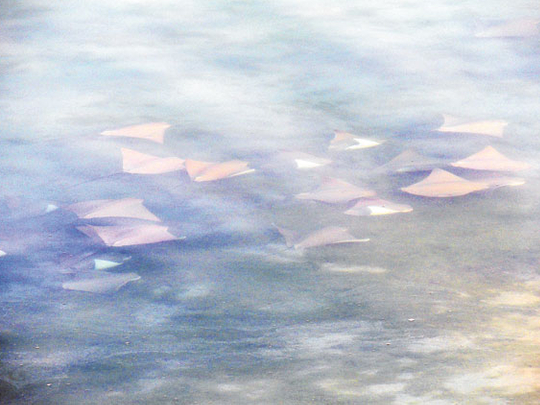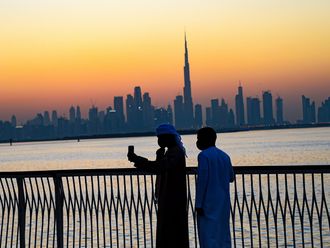
Dubai: Prevarications that artificial islands created off Dubai shores would never play host as a natural habitat to marine animals are being proved wrong with the arrival in recent days of a massive school of cownose rays.
Residents of villas living along the fronds of Palm Jumeirah have been mesmerized at the almost hourly sightings of a school of the rays that reaches by some estimates as long as 300 metres.
The splashes of the rays playing in the calm protected waters between the fronds are quite visible because the native Gulf species are swimming near the surface in the shallows as witnessed by Gulf News on a site visit.
Marcel Kardol, 47, is an IT executive who moved to his Palm villa in July and said his family first noticed the large school on November 1 moving past his home resembling a long dark underwater train of sorts.
On some days, the passing happens on the hour every hour in early morning light.
“You can see the odd ray or two swimming around but to see this many in the hundreds moving silently through the water, it is like a miracle,” Kardol told Gulf News from his beachfront home. “Obviously they like it here. There must be a lots of food such as starfish and small shrimps.”
Kardol said he has no proof but figures that the large school probably entered the protected Palm waters through the northwest opening along the seawall and have stayed since.
In recent days, the large school has broken up into smaller pods of rays which are now roaming a larger area.
He said he was surprised at how physically active they are in the water.
It’s unlikely any will be harmed from boatstrikes since the Palm waters between the fronds are protected and security vessels prohibit any mechanized boating in the area.
“It’s a nice view to wake up to in the morning,” Kardol said.
Steve Kaiser, vice-president Marine Sciences and Engineering at Atlantis The Palm, said he was pleased to hear of the appearance of the rays en masse in the wild and noted that he wasn’t surprised at all that more and more marine life is finding its way back into the area.
The sandy seabottom of the Palm frond waters is ideal for the cow nose rays which can reach more than one metre in width and more than 20 kilograms in weight.
Kaiser said cownose rays like to “dig up clams, shrimps with their nose. They get their nose right into the sand, they make little indentations in the hunt for food.”
Asked to speculate on the sudden appearance of so many of the rays, Kaiser said its hard to pinpoint any single cause but pointed out that “the water gets so hot in the summer, that they go offshore into deeper waters. With the weather getting cooler now, they moving back into shallow water.”
Given a lack of empirical data on species such as the cownose ray in the Gulf – like many other species – its difficult to say with any certainty whether the rays are in the Palm to spawn, feed or simply migrate to another section of the Gulf.
However, one thing is for sure, he said.
“You’re going to see more and more of this kind of stuff,” Kaiser ventured. “I think they have always migrated up and down the coast but now they have a lot more habitat.”












